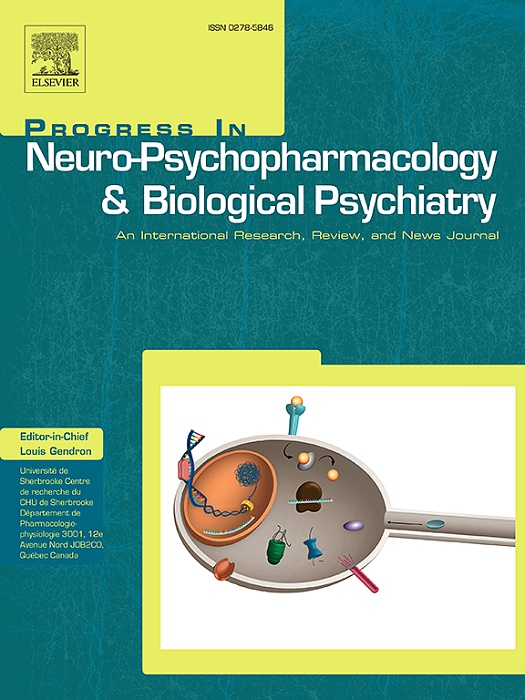NRN1 genetic variability and methylation changes as biomarkers for cognitive remediation therapy response in schizophrenia
IF 5.3
2区 医学
Q1 CLINICAL NEUROLOGY
Progress in Neuro-Psychopharmacology & Biological Psychiatry
Pub Date : 2024-10-18
DOI:10.1016/j.pnpbp.2024.111175
引用次数: 0
Abstract
Cognitive remediation therapy (CRT) demonstrates potential in enhancing cognitive function in schizophrenia (SZ), though the identification of molecular biomarkers remains challenging. The Neuritin-1 gene (NRN1) emerges as a promising candidate gene due to its association with SZ, cognitive performance and response to neurotherapeutic treatments. We aimed to investigate whether NRN1 genetic variability and methylation changes following CRT are related to cognitive improvements.
Twenty-five SZ patients were randomly assigned to CRT or treatment-as-usual (TAU) groups, with cognitive function and NRN1 methylation assessed pre- and post-intervention using the MATRICS Consensus Cognitive Battery and EpiTYPER. Besides, eleven NRN1 polymorphisms were genotyped. Methylation changes (Δm = post - pre) were analyzed via sparse Partial Least Square Discriminant Analysis (sPLS-DA) to identify latent components (LCs) distinguishing CRT from TAU. To further explore methylation patterns of these LCs, CpG units were grouped into two subsets, yielding Δm means for those with increased and decreased methylation. Cognitive changes (Δcog = post - pre) were used to identify CRT improvers (CRT-I, Δcog ≥ 1), and the association between methylation changes and cognitive improvements post-therapy was also tested.
We identified two LCs that differentiated CRT from TAU with a classification error rate of 0.28. The main component, LC1, included 25 CpG units. The subsets of CpG units with increased and decreased post-therapy methylation differed significantly between the two treatment arms, suggesting that differences were not merely data-driven but reflected meaningful biological variation. Additionally, CpG units linked to therapy were also associated with cognitive improvement, with LC1 and the subset of CpG units showing increased methylation post-therapy distinguishing CRT-I from the rest of the patients across multiple cognitive domains. Furthermore, the effect of LC1 on speed processing improvement after CRT was enhanced by considering the NRN1-rs9405890 polymorphism. Notably, these CpG units, particularly those with increased methylation after CRT, overlapped with key gene regulatory elements.
Our model, integrating genetics and epigenetics, boosts the understanding of CRT response variability and highlights this multi-level approach as a promising strategy for identifying potential NRN1-related biomarkers of CRT effects, though further studies with larger samples are needed.
将 NRN1 基因变异和甲基化变化作为精神分裂症患者认知矫正治疗反应的生物标志物。
认知矫正治疗(CRT)在增强精神分裂症(SZ)患者的认知功能方面具有潜力,但分子生物标志物的鉴定仍具有挑战性。神经营养素-1基因(NRN1)与精神分裂症、认知能力和对神经疗法的反应有关,因此成为一个有希望的候选基因。我们旨在研究 CRT 后 NRN1 基因变异和甲基化变化是否与认知能力改善有关。25名SZ患者被随机分配到CRT组或治疗照常组(TAU),使用MATRICS共识认知测验和EpiTYPER评估干预前后的认知功能和NRN1甲基化。此外,还对 11 种 NRN1 多态性进行了基因分型。甲基化变化(Δm = 后-前)通过稀疏偏最小平方判别分析(sPLS-DA)进行分析,以确定区分CRT和TAU的潜在成分(LC)。为进一步探索这些潜在成分的甲基化模式,将 CpG 单元分为两个子集,得出甲基化增加和减少的 CpG 单元的 Δm 平均值。认知变化(Δcog = 治疗后 - 治疗前)被用来识别 CRT 改善者(CRTI,Δcog ≥1),甲基化变化与治疗后认知改善之间的关联也被测试出来。我们确定了两个 LCs,它们能将 CRT 与 TAU 区分开来,分类错误率为 0.28。主要成分 LC1 包括 25 个 CpG 单元。治疗后甲基化增加和减少的 CpG 单元子集在两个治疗组之间存在显著差异,这表明差异不仅仅是数据驱动的,而是反映了有意义的生物学变异。此外,与治疗相关的 CpG 单元也与认知改善有关,LC1 和治疗后甲基化增加的 CpG 单元子集在多个认知领域将 CRT-I 与其他患者区分开来。此外,考虑到 NRN1-rs9405890 多态性,LC1 对 CRT 后速度处理改善的影响得到了加强。值得注意的是,这些CpG单元,尤其是那些在CRT后甲基化增加的单元,与关键的基因调控元件重叠。我们的模型整合了遗传学和表观遗传学,加深了人们对 CRT 反应变异性的理解,并强调了这种多层次方法是一种很有前景的策略,可用于鉴定 CRT 效果的潜在 NRN1 相关生物标记物,不过还需要对更大样本进行进一步研究。
本文章由计算机程序翻译,如有差异,请以英文原文为准。
求助全文
约1分钟内获得全文
求助全文
来源期刊
CiteScore
12.00
自引率
1.80%
发文量
153
审稿时长
56 days
期刊介绍:
Progress in Neuro-Psychopharmacology & Biological Psychiatry is an international and multidisciplinary journal which aims to ensure the rapid publication of authoritative reviews and research papers dealing with experimental and clinical aspects of neuro-psychopharmacology and biological psychiatry. Issues of the journal are regularly devoted wholly in or in part to a topical subject.
Progress in Neuro-Psychopharmacology & Biological Psychiatry does not publish work on the actions of biological extracts unless the pharmacological active molecular substrate and/or specific receptor binding properties of the extract compounds are elucidated.

 求助内容:
求助内容: 应助结果提醒方式:
应助结果提醒方式:


